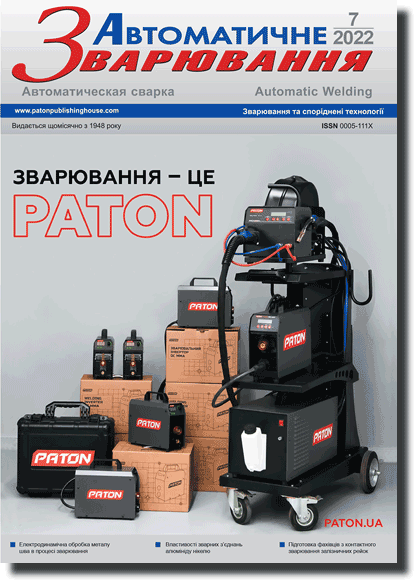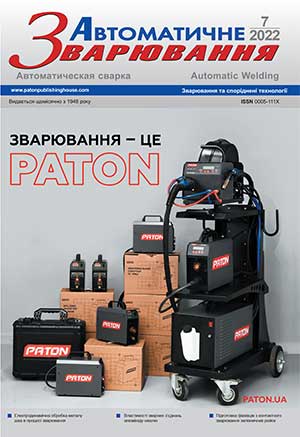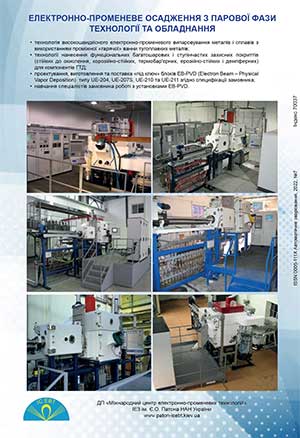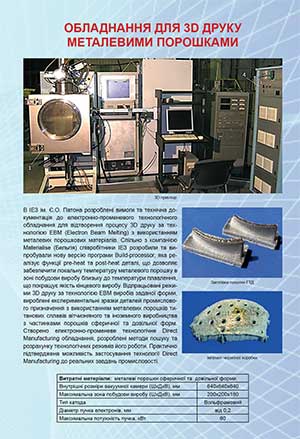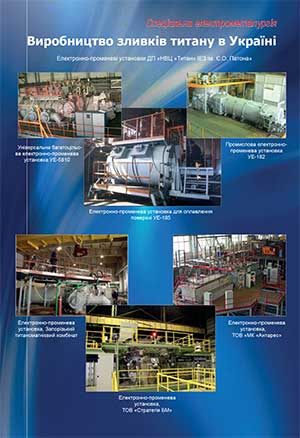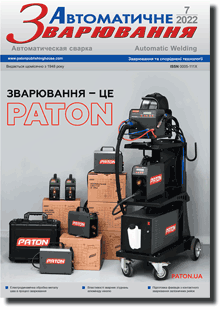
Avtomaticheskaya Svarka (Automatic Welding), #7, 2022, pp. 42-48
E.O. Paton Electric Welding Institute of the NAS of Ukraine. 11 Kazymyr Malevych Str., 03150, Kyiv, Ukraine. E-mail: office@paton.kiev.ua
The results of the study of the phase composition and corrosion resistance of plasma coatings from composite powders based on intermetallics in TiAl with the introduction of non-metallic refractory compounds (SiC or Si3N4) are presented. The plasma coatings were deposited to the specimens of St3, AMg3 and VT6 alloys. The coatings were investigated by the methods of metallographic and X-ray structural phase analysis. The studies of electrochemical properties of the plasma coatings were carried out by the potentiostatic method in a 3% NaCl solution. As initial materials for plasma spraying, composite powders TiAl–SiC, TiAl–Si3N4 produced by the method of mechanochemical synthesis were used. Using the method of X-ray structural analysis, it was revealed that the phase composition of the plasma coatings for the TiAl–SiC system consists of the following phases: TiAl, TiAl3, TiC, Ti5Si3, Ti3AlC, TiO2, and for the coating TiAl–Si3N4 from phases Ti2Al, Ti5Si3, TiN, TiO. The average thickness of the coatings was 200 ± 50 μm, the porosity did not exceed 10%. It was found that the introduction of SiC or Si3N4 into the composition of the composite coating leads to a decrease in the corrosion current in a 3% NaCl solution by about an order of value, and the corrosion resistance of St3, АМg3 and VТ6 alloys increases by 12...13, 8...9, and 1.8...2.0 times, respectively. The service life of the plasma coatings made of TiAl composite powders with the addition of SiC and Si3N4 was calculated. The studied coatings belong to the class of resistant and are capable to protect metals in a 3% NaCl solution for a period from 6 to 10 years. 20 Ref., 2 Tabl., 5 Fig.
Keywords: intermetallics, titanium, aluminum, non-metallic refractory compounds, composite powder, plasma coatings, corrosion resistance
Received: 09.06.2022
2. Kablov, E.N., Lukin, V.I. (2008) Intermetallics based on titanium and nickel for advanced engineering products. The Paton Welding J., 11, 65-70.
3. Kurzina, I, A., Kozlov, E., Sharkeev, Yu. (2007) Influence of ion implantation on nanoscale intermetallic-phase formation in Ti-Al, Ni-Al and Ni-Ti systems. Surf. Coat. Tech., 201, 8463-8468. https://doi.org/10.1016/j.surfcoat.2006.02.062
4. Cinca, N., Guilemany, J. (2012) Thermal spraying of transition metal aluminides: An overview. Intermetallics, 24, 60-72. https://doi.org/10.1016/j.intermet.2012.01.020
5. Yang, D., Tian, B., Cao, Y. (2011) Microstructures and properties of FeAl coatings prepared by LPPS, APS and HVOF. Proc. of ITSC`2011, 1229-1234.
6. Cinca, N., Guilemany, J. (2013) An overview of intermetallics research and application: Status of thermal spray coatings. J. of Materials Research and Technology, 2(1), 1-11. https://doi.org/10.1016/j.jmrt.2013.03.013
7. Syrovatka, V.L., Oliker, V.E., Yakovleva, M.S. (2013) Intermetallics of Fe-Al system: Methods of producing, properties, coatings. Materialovedenie, 3, 46-53 [in Russian].
8. Grigorenko, S.G. Grigorenko, G.M., Zadorozhnyuk, O.M. (2017) Intermetallics of titanium. Peculiar features, properties, application (Review). Sovrem. Electrometal., 3, 51-58 [in Russian]. https://doi.org/10.15407/sem2017.03.08
9. Blinkov, P.R., Volkhonsky, V.S., Sergevnin, N.Yu. (2015) Structure- and phase formation in Ti-Al-Si-N system at forming of nanostructural ion-plasma coatings. Neorganicheskie Materialy, 51(11), 34-38 [in Russian]. https://doi.org/10.1134/S0020168515100027
10. Voronov, A.V., Sergeev, V.P., Sergeev, O.V. et al. (2009) Producing of nanocomposite coatings based on Ti-Al-Si-N system using two magnetrons. Izv. TPU, Engineering Georesursov, 315(2), 147-150 [in Russian].
11. Pyachin, S.A., Ershova, A.A., Vlasova, N.M. et al. (2019) Preparation and properties of electrospark coatings from Ti3Al granules with silicon carbide and boron carbide additives. Letter Materials, 9(2), 191-196. https://doi.org/10.22226/2410-3535-2019-2-191-196
12. Vojtovich, R.F. (1981) Oxidation of carbides and nitrides. Kyiv, Naukova Dumka [in Russian].
13. Vojtovich, R.F., Golovko, E.I. (1978) High-temperature oxidation of metals and alloys. Kyiv, Naukova Dumka [in Russian].
14. Nikitin, V.I. (1987) Corrosion and protection of gas turbine blades. Moscow, Mashinostroenie [in Russian].
15. Zhuk, N.P. (2006) Course in the theory of corrosion and protection of metals. Moscow, Alliance [in Russian].
16. Seikh, A.H. (2015) Corrosion behavior in 3,5% NaCl solutions of γ-TiAl processed by electron beam melting process. Metals, 5, 2289-2302. https://doi.org/10.3390/met5042289
17. Shein, A.B. (2010) Corrosion-electrochemical behavior of metal silicides of iron triad in different electrolytes. Fizikokhimiya Poverkhnosti i Zashchita Metallov, 4(46), 403-413 [in Russian]. https://doi.org/10.1134/S2070205110040155
18. Knyazheva, V.M., Babich, S.G., Kolotyrkin, V.I., Kozhevnikov, V.B. (1991) Metal-like compounds of transition metals as the new class of corrosion-resistant materials and protective coatings. Zashchita Metallov, 4(27), 603-616 [in Russian]. https://doi.org/10.1007/BF01245287
19. Tomashov, N.D., Chernova, G.P. (1993) Theory of corrosion and corrosion-resistant structural alloys. Moscow, Metallurgiya [in Russian].
20. Burkov, A., Pyachin, S., Vlasova, N. et al. (2018) Improvement of anticorrosion and tribotechnical properties of Ti6Al4V alloy by deposition of electrospark Ti-Al-Si-C coatings. Obrabotka Metallov, 20(3), 85-96.
AS = «Automatic Welding» - 6 issues per year;
TPWJ = «PATON WELDING JOURNAL» - 12 issues per year;
SEM = «Electrometallurgy Today» - 4 issues per year;
TDNK = «Technical Diagnostics and Non-Destructive Testing» - 4 issues per year.
| 2022 №07 (06) |
DOI of Article 10.37434/as2022.07.07 |
2022 №07 (08) |

Avtomaticheskaya Svarka (Automatic Welding), #7, 2022, pp. 42-48
Corrosion resistance of plasma coatings produced from composite TiAl-based powders with the addition of non-metallic refractory compounds
Yu.S. Borysov, A.L. Borysova, N.V. Vigilyanska, O.P. Gryshchenko, Z.G. Ipatova, K.V. Yantsevych, M.A. Vasylkivska
E.O. Paton Electric Welding Institute of the NAS of Ukraine. 11 Kazymyr Malevych Str., 03150, Kyiv, Ukraine. E-mail: office@paton.kiev.ua
The results of the study of the phase composition and corrosion resistance of plasma coatings from composite powders based on intermetallics in TiAl with the introduction of non-metallic refractory compounds (SiC or Si3N4) are presented. The plasma coatings were deposited to the specimens of St3, AMg3 and VT6 alloys. The coatings were investigated by the methods of metallographic and X-ray structural phase analysis. The studies of electrochemical properties of the plasma coatings were carried out by the potentiostatic method in a 3% NaCl solution. As initial materials for plasma spraying, composite powders TiAl–SiC, TiAl–Si3N4 produced by the method of mechanochemical synthesis were used. Using the method of X-ray structural analysis, it was revealed that the phase composition of the plasma coatings for the TiAl–SiC system consists of the following phases: TiAl, TiAl3, TiC, Ti5Si3, Ti3AlC, TiO2, and for the coating TiAl–Si3N4 from phases Ti2Al, Ti5Si3, TiN, TiO. The average thickness of the coatings was 200 ± 50 μm, the porosity did not exceed 10%. It was found that the introduction of SiC or Si3N4 into the composition of the composite coating leads to a decrease in the corrosion current in a 3% NaCl solution by about an order of value, and the corrosion resistance of St3, АМg3 and VТ6 alloys increases by 12...13, 8...9, and 1.8...2.0 times, respectively. The service life of the plasma coatings made of TiAl composite powders with the addition of SiC and Si3N4 was calculated. The studied coatings belong to the class of resistant and are capable to protect metals in a 3% NaCl solution for a period from 6 to 10 years. 20 Ref., 2 Tabl., 5 Fig.
Keywords: intermetallics, titanium, aluminum, non-metallic refractory compounds, composite powder, plasma coatings, corrosion resistance
Received: 09.06.2022
References
1. Sinelnikova, V., Podergin, V., Rechkin, (1965) Aluminides. Kyiv, Naukova Dumka [in Russian].2. Kablov, E.N., Lukin, V.I. (2008) Intermetallics based on titanium and nickel for advanced engineering products. The Paton Welding J., 11, 65-70.
3. Kurzina, I, A., Kozlov, E., Sharkeev, Yu. (2007) Influence of ion implantation on nanoscale intermetallic-phase formation in Ti-Al, Ni-Al and Ni-Ti systems. Surf. Coat. Tech., 201, 8463-8468. https://doi.org/10.1016/j.surfcoat.2006.02.062
4. Cinca, N., Guilemany, J. (2012) Thermal spraying of transition metal aluminides: An overview. Intermetallics, 24, 60-72. https://doi.org/10.1016/j.intermet.2012.01.020
5. Yang, D., Tian, B., Cao, Y. (2011) Microstructures and properties of FeAl coatings prepared by LPPS, APS and HVOF. Proc. of ITSC`2011, 1229-1234.
6. Cinca, N., Guilemany, J. (2013) An overview of intermetallics research and application: Status of thermal spray coatings. J. of Materials Research and Technology, 2(1), 1-11. https://doi.org/10.1016/j.jmrt.2013.03.013
7. Syrovatka, V.L., Oliker, V.E., Yakovleva, M.S. (2013) Intermetallics of Fe-Al system: Methods of producing, properties, coatings. Materialovedenie, 3, 46-53 [in Russian].
8. Grigorenko, S.G. Grigorenko, G.M., Zadorozhnyuk, O.M. (2017) Intermetallics of titanium. Peculiar features, properties, application (Review). Sovrem. Electrometal., 3, 51-58 [in Russian]. https://doi.org/10.15407/sem2017.03.08
9. Blinkov, P.R., Volkhonsky, V.S., Sergevnin, N.Yu. (2015) Structure- and phase formation in Ti-Al-Si-N system at forming of nanostructural ion-plasma coatings. Neorganicheskie Materialy, 51(11), 34-38 [in Russian]. https://doi.org/10.1134/S0020168515100027
10. Voronov, A.V., Sergeev, V.P., Sergeev, O.V. et al. (2009) Producing of nanocomposite coatings based on Ti-Al-Si-N system using two magnetrons. Izv. TPU, Engineering Georesursov, 315(2), 147-150 [in Russian].
11. Pyachin, S.A., Ershova, A.A., Vlasova, N.M. et al. (2019) Preparation and properties of electrospark coatings from Ti3Al granules with silicon carbide and boron carbide additives. Letter Materials, 9(2), 191-196. https://doi.org/10.22226/2410-3535-2019-2-191-196
12. Vojtovich, R.F. (1981) Oxidation of carbides and nitrides. Kyiv, Naukova Dumka [in Russian].
13. Vojtovich, R.F., Golovko, E.I. (1978) High-temperature oxidation of metals and alloys. Kyiv, Naukova Dumka [in Russian].
14. Nikitin, V.I. (1987) Corrosion and protection of gas turbine blades. Moscow, Mashinostroenie [in Russian].
15. Zhuk, N.P. (2006) Course in the theory of corrosion and protection of metals. Moscow, Alliance [in Russian].
16. Seikh, A.H. (2015) Corrosion behavior in 3,5% NaCl solutions of γ-TiAl processed by electron beam melting process. Metals, 5, 2289-2302. https://doi.org/10.3390/met5042289
17. Shein, A.B. (2010) Corrosion-electrochemical behavior of metal silicides of iron triad in different electrolytes. Fizikokhimiya Poverkhnosti i Zashchita Metallov, 4(46), 403-413 [in Russian]. https://doi.org/10.1134/S2070205110040155
18. Knyazheva, V.M., Babich, S.G., Kolotyrkin, V.I., Kozhevnikov, V.B. (1991) Metal-like compounds of transition metals as the new class of corrosion-resistant materials and protective coatings. Zashchita Metallov, 4(27), 603-616 [in Russian]. https://doi.org/10.1007/BF01245287
19. Tomashov, N.D., Chernova, G.P. (1993) Theory of corrosion and corrosion-resistant structural alloys. Moscow, Metallurgiya [in Russian].
20. Burkov, A., Pyachin, S., Vlasova, N. et al. (2018) Improvement of anticorrosion and tribotechnical properties of Ti6Al4V alloy by deposition of electrospark Ti-Al-Si-C coatings. Obrabotka Metallov, 20(3), 85-96.
Advertising in this issue:
The cost of subscription/purchase order journals or individual articles
| Journal/Currency | Annual Set | 1 issue printed |
1 issue |
one article |
| AS/UAH | 1800 UAH | 300 UAH | 300 UAH | 150 UAH |
| AS/USD | 192 $ | 32 $ | 26 $ | 16 $ |
| AS/EUR | 180 € | 30 € | 25 € | 15 € |
| TPWJ/UAH | 7200 UAH | 600 UAH | 600 UAH | 280 UAH |
| TPWJ/USD | 384 $ | 32 $ | 26 $ | 16 $ |
| TPWJ/EUR | 360 € | 30 € | 25 € | 15 € |
| SEM/UAH | 1200 UAH | 300 UAH | 300 UAH | 150 UAH |
| SEM/USD | 128 $ | 32 $ | 26 $ | 16 $ |
| SEM/EUR | 120 € | 30 € | 25 € | 15 € |
| TDNK/UAH | 1200 UAH | 300 UAH | 300 UAH | 150 UAH |
| TDNK/USD | 128 $ | 32 $ | 26 $ | 16 $ |
| TDNK/EUR | 120 € | 30 € | 25 € | 15 € |
AS = «Automatic Welding» - 6 issues per year;
TPWJ = «PATON WELDING JOURNAL» - 12 issues per year;
SEM = «Electrometallurgy Today» - 4 issues per year;
TDNK = «Technical Diagnostics and Non-Destructive Testing» - 4 issues per year.





